Five years ago, we did a post about Cinémagazine. Cinémagazine-Edition or CE was a small French publishing company, located in Paris, which had a good reputation. Cinémagazine's star postcards from the 1920s and 1930s are still mesmerising. Recently, we found a lot of Cinémagazine postcard which we share with you in two posts. Today, the second post with cards of the early 1930s in which the photos have a white frame. At the end of the production, the postcards also came in a lighter version, and sometimes also the colour differed. There were even of few coloured cards.
Image may be NSFW.
Clik here to view.
French postcard by Cinémagazine-Edition, Paris, no. 46.
Suzanne Delmas (1901–1984) was a French film actress, who acted in 12 French and German silent films between 1923 and 1930. These included the spy drama L'espionne aux yeux noirs (1926), Poker d'as (Henri Desfontaines, 1928), Dornenweg einer Fürstin/Rasputin (Nikolai Larin, Boris Nevolin, 1928) starring Gregori Chmara, and Souris d'hôtel (Adelqui Migliar, 1929) with Ica von Lenkeffy. Le procureur Hallers (Robert Wiene, 1930) was her first sound film but also her last film.
Image may be NSFW.
Clik here to view.
French postcard by Cinémagazine-Edition, no. 91. Emil Jannings in The Last Command (Josef von Sternberg, 1928).
If Weimar cinema had one film star, then it was Emil Jannings (1884-1950) for sure. He was a great actor in the silent era and won the first Oscar for Best Actor. Priceless are his performances as Louis XV in Lubitsch'Madame Dubarry (1919), as the doorman in Murnau's The Last Laugh (1924), the jealous acrobat in Dupont's Variety (1925) and the professor in Von Sternberg's The Blue Angel (1930).
Image may be NSFW.
Clik here to view.
French postcard by Cinémagazine-Edition, Paris, no. 438.
English gentleman-actor Ronald Colman (1891-1958) was a top box office draw in Hollywood films throughout the 1920s, 1930s, and 1940s. ‘The man with the velvet voice’ was nominated for four Academy Awards. In 1948 he finally won the Oscar for his splendid portrayal of a tormented actor in A Double Life.
Image may be NSFW.
Clik here to view.
French postcard by Cinémagazine-Edition, Paris, no. 445. Photo: Paramount.
Projected as wholesome but fun-loving, Maine-born leading lady Esther Ralston (1902-1994) enjoyed a prime silent age career. She appeared in close to 100 films over a nearly 30-year period. At her peak, she was packaged and publicised as 'The American Venus' by Florenz Ziegfeld Jr. after appearing as a dazzling beauty queen in the film The American Venus (1926). A decade later, the blonde beauty's career, however, had tapered off.
Image may be NSFW.
Clik here to view.
French postcard by Cinémagazine-Edition, Paris, no. 521. Douglas Fairbanks and Lupe Velez in The Gaucho (F. Richard Jones, 1927). Sent by mail in 1930.
American actor Douglas Fairbanks (1883-1939) was best known for his swashbuckling roles in silent films such as The Mark of Zorro (1920), Robin Hood (1922), and The Thief of Bagdad (1924), but spent the early part of his career making comedies. Fairbanks was a founding member of United Artists and of The Motion Picture Academy. Lupe Velez (1908-1944), was one of the first Mexican actresses to succeed in Hollywood. Her nicknames were 'The Mexican Spitfire' and 'Hot Pepper'. She was the leading lady in such silent films as The Gaucho (1927), Lady of the Pavements (1928), and Wolf Song (1929). During the 1930s, her well-known explosive screen persona was exploited in a series of successful films like Hot Pepper (1933), Strictly Dynamite (1934), and Hollywood Party (1934). In the 1940s, Vélez's popularity peaked after appearing in the Mexican Spitfire films.
Image may be NSFW.
Clik here to view.
French postcard by Cinémagazine-Edition, Paris, no. 524.
French actor Jean Murat (1888-1968) became a star as a handsome young soldier in silent films of the 1920s. Later, he appeared in such classic French films as La Kermesse Heroique (1935) and L'Eternal Retour (1943).
Image may be NSFW.
Clik here to view.
French postcard by Cinémagazine-Edition, no. 568. Photo: Fox Film.
American film actor Tom Mix (1880-1940) was the star of many early Westerns between 1909 and 1935. Mix appeared in 291 films, all but nine of which were silent movies. He was Hollywood's first Western megastar and helped to define the genre for all cowboy actors who followed.
Image may be NSFW.
Clik here to view.![Albert Préjean and Gaby Morlay in Les nouveaux messieurs (1928)]()
French postcard by Cinémagazine-Edition, Paris, no. 589. Albert Préjean and Gaby Morlay in Les nouveaux messieurs/The New Gentlemen (Jacques Feyder, 1928).
Gaby Morlay (1893-1964) was a French actress with a long-standing career, playing in over 100 films. She compensated for her small size (1.53 m.) with passion and enthusiasm. French actor and singer Albert Préjean (1894-1979) was a former WWI flying ace. He is best known for playing heroes in the silent and early sound films of René Clair, and for playing George Siménon's detective Maigret.
Image may be NSFW.
Clik here to view.![Henry Roussel in Les nouveaux messieurs (1928)]()
French postcard by Cinémagazine-Edition, Paris, no. 591. Henry Roussel in Les nouveaux messieurs/The New Gentlemen (Jacques Feyder, 1928).
Henry Roussel (1875–1946), also known as Henry Roussell, was a French silent film actor, film director, and screenwriter best known for his silent films of the 1910s and 1920s. He starred in well over 40 films between 1912 and 1939 and directed such films as Visages voilés... âmes closes (1921), Les opprimés (1923), Violettes impériales/Imperial Violets (1924) and Paris' Girls (1929), while in the early 1910s he was a regular actor of the Eclair company, often directed by Maurice Tourneur, and later on had memorable parts in e.g. Les nouveaux messieurs (1929).
Image may be NSFW.
Clik here to view.![Emil Jannings and Florence Vidor in The Patriot (1928)]()
French postcard by Cinémagazine-Edition, no. 607. Emil Janningsand Florence Vidor in The Patriot (Ernst Lubitsch, 1928).
If Weimar cinema had one film star, then it was Emil Jannings (1884-1950) for sure. He was a great actor in the silent era and won the first Oscar for Best Actor. Priceless are his performances as Louis XV in Lubitsch'Madame Dubarry (1919), as the doorman in Murnau's The Last Laugh (1924), the jealous acrobat in Dupont's Variety (1925) and the professor in Von Sternberg's The Blue Angel (1930).
Image may be NSFW.
Clik here to view.![Emil Jannings in The Patriot (1928)]()
French postcard by Cinémagazine-Edition, no. 608. Emil Jannings again in The Patriot (Ernst Lubitsch, 1928).
Image may be NSFW.
Clik here to view.![Dorothy Jordan in Devil-May-Care (1929)]()
French postcard by Cinémagazine-Edition, Paris, no. 613. Dorothy Jordan in Devil-May-Care (Sidney Franklin, 1929). The French title was Bataille de Dames.
Dorothy Jordan (1906-1988) was an American film actress, who emerged at the start of the talkies. She made her film debut in 1929 as Mary Pickford's sister in Sam Taylor's The Taming of the Shrew. Jordan worked for various studios and until 1933 played the female lead in various films. Important parts she had in Min and Bill (1930) with Wallace Beery and Marie Dressler and in The Cabin in the Cotton (1932) with Bette Davis. In 1933 Jordan left the film industry to marry film producer and director Merian C. Cooper.
Image may be NSFW.
Clik here to view.![George Bancroft]()
French postcard by Cinémagazine-Edition, Paris, no. 630. Photo: Paramount.
Burly, beefy and tall George Bancroft (1882-1956) was an American film and stage actor who played many ill-tempered tough guys. He received an Oscar nomination for his part as Thunderbolt Jim Lang in Josef von Sternberg's gangster film Thunderbolt (1929). Bancroft is also well remembered as Marshal Curly Wilcox in John Ford's Western Stagecoach (1939).
Image may be NSFW.
Clik here to view.![Bessie Love in The Broadway Melody (1929)]()
French postcard by Cinémagazine-Edition, Paris, no. 660. Photo: Metro-Goldwyn-Mayer. Bessie Love in The Broadway Melody (Harry Beaumont, 1929).
American actress Bessie Love (1898-1986) was introduced to the cinema by D.W. Griffith. He also gave the actress her screen name. She played innocent young girls and wholesome leading ladies in silent films and early talkies. Her acting career spanned eight decades, and her role in The Broadway Melody (1929) earned her a nomination for the Oscar for Best Actress.
Image may be NSFW.
Clik here to view.![Anny Ondra in Sündig und süß / Anny de Montparnasse (1929)]()
French postcard by Cinémagazine-Edition, Paris, no. 707. Photo: Sofar. Anny Ondra in Sündig und süß/Sinful and Sweet (Carl Lamac, 1929), released in France as Anny de Montparnasse.
Anny Ondra (1903-1987) was a Polish-Czech-Austrian-German-French singer, film, and stage actress. During the 1920s and 1930s, she was a popular actress in Czech, Austrian and German comedies, and she was Alfred Hitchcock’s first ‘Blonde’.
Image may be NSFW.
Clik here to view.![Ina Claire]()
French postcard by Cinémagazine-Edition, Paris, no. 738.
Ina Claire (1893-1985) was an American stage and film actress. In the 1910s, 1920s, and 1930s, she was a big Broadway star. She could be seen in several early Pre-Code sound films such as the first version of The Awful Truth (1929), but she is best remembered as Grandduchess Swana in Ninotchka (1939) by Ernst Lubitsch, starring Greta Garbo. Claire was married to actor John Gilbert in 1929-1931.
Image may be NSFW.
Clik here to view.![Suzanne Bianchetti in Cagliostro (1929)]()
French postcard by Cinémagazine-Edition, Paris, no. 747. Photo: Alban. Suzanne Bianchetti as Queen Marie-Antoinette of France in the Franco-German coproduction Cagliostro (Richard Oswald, 1929). The year written on the card does not refer to the French release, as that was in 1929 as well.
French film actress Suzanne Bianchetti (1889-1936) was one of France's most loved and respected actresses of her time. She played Marie Antoinette in Abel Gance's epic Napoléon (1927) and worked with many other great names of the silent cinema. After her death the Prix Suzanne Bianchetti was created in her memory, an annual French award to be given to the most promising young actress.
Image may be NSFW.
Clik here to view.![Georges Colin]()
French postcard by Cinémagazine-Edition, Paris, no. 792.
Georges Colin (1880-1945) was a French actor, who appeared in nearly 40 silent and sound films between 1909 and 1945.
Image may be NSFW.
Clik here to view.![Annabella]()
French postcard by Cinémagazine-Edition, Paris, no. 928. Photo: Ruben Sobol, Paris.
French film star Annabella (1909-1996) was France's most popular actress during the mid-1930s, but she also achieved some success in Hollywood films of the late 1930s.
Image may be NSFW.
Clik here to view.![Albert Préjean and Annabella in Un soir de rafle (1931)]()
French postcard by Cinémagazine-Edition, Paris, no. 929. Photo: Les Films Osso. Albert Préjean and Annabella in Un soir de rafle/Dragnet Night (Carmine Gallone, 1931).
French actor and singer Albert Préjean (1894-1979) was a former WWI flying ace. He is best known for playing heroes in the silent and early sound films of René Clair, and for playing George Siménon's detective Maigret. French film star Annabella (1909-1996) was France's most popular actress during the mid-1930s, but she also achieved some success in Hollywood films of the late 1930s.
Image may be NSFW.
Clik here to view.![Fernand Gravey]()
French postcard by Cinémagazine-Édition, Paris, no. 930. Photo: Paramount.
Fernand Gravey (1905-1970) was an elegant Franco-Belgian stage, screen, and television actor, successfully working in Belgium, France, England, and Hollywood. He was also a war hero, who was active as a member of the French Intelligence and in particular for the Foreign Legion during the Second World War.
Image may be NSFW.
Clik here to view.![Meg Lemonnier]()
French postcard by Cinémagazine-Edition, Paris, no. 938. Photo: Paramount.
French actress and singer Meg Lemonnier (1905-1988) was most active in the French cinema of the 1930s.
Image may be NSFW.
Clik here to view.![Charles Boyer]()
French postcard by Cinémagazine-Edition, Paris, no. 942. Photo: Metro-Goldwyn-Mayer.
Suave and sophisticated French actor Charles Boyer (1899-1978) began his career in French silent films and in 1936 he became an international star with his role in Mayerling opposite Danielle Darrieux. His long career earned him the title of 'the last of the cinema's great lovers'.
Image may be NSFW.
Clik here to view.![Jean Murat]()
French postcard by Cinémagazine-Edition, Paris, no. 1018. Photo: Studio Rudolph.
French actor Jean Murat (1888-1968) became a star as a handsome young soldier in silent films of the 1920s. Later, he appeared in such classic French films as La Kermesse Heroique (1935) and L'Eternal Retour (1943).
Image may be NSFW.
Clik here to view.![Lilian Harvey]()
French postcard by Cinémagazine-Edition, Paris, no. 1024. Photo: Studio Intran.
British born, German actress and singer Lilian Harvey (1906-1968) was Ufa's biggest star of the 1930s. With Willy Fritsch, she formed the 'Dream Team of the European Cinema'. Their best film was the immensely popular film operetta Der Kongress tanzt/The Congress Dances (Erik Charell, 1931).
Image may be NSFW.
Clik here to view.![Fernand Gravey]()
French postcard by Cinémagazine-Édition, Paris, no. 1063. Photo: Paramount. Fernand Gravey in Coiffeur pour dames/Ladies Hairdresser (René Guissart, 1932).
Fernand Gravey (1905-1970) was an elegant Franco-Belgian stage, screen, and television actor, successfully working in Belgium, France, England, and Hollywood. He was also a war hero, who was active as a member of the French Intelligence and in particular for the Foreign Legion during the Second World War.
Image may be NSFW.
Clik here to view.![Meg Lemonnier]()
French postcard by Cinémagazine-Edition, Paris, no. 2007. Photo: Paramount.
French actress and singer Meg Lemonnier (1905-1988) was most active in the French cinema of the 1930s.
Image may be NSFW.
Clik here to view.![Anita Page]()
French postcard by Cinémagazine-Edition, Paris, no. 2011. Photo: Metro Goldwyn Mayer.
Beautiful Anita Page (1910–2008) was one of the most popular leading ladies of Hollywood during the last years of the silent screen and the first years of the sound era.
Image may be NSFW.
Clik here to view.![Grazia Del Rio]()
French postcard by Cinémagazine-Editions, no. 2021. Photo: Studio Piaz.
Little is known about the personal life of Italian actress and singer Grazia Del Rio, but probably because of her singing voice and clear vocals she had a prolific career in the earliest years of sound cinema. Between 1930 and 1933 she had a short but intense film career in Italy and France, peaking with La Stella del cinema (Mario Almirante, 1931) in which she starred herself. In the late 1930s, she had a second career in Argentina and Chile.
Image may be NSFW.
Clik here to view.![Christiane Delyne]()
French postcard by Cinémagazine-Edition, Paris, no. 2067. Photo: Studio Rudolph, Paris.
Christiane Delyne (1902–1966) was an American-born French actress, whose film career peaked in early and mid-1930s French sound cinema.
Image may be NSFW.
Clik here to view.

French postcard by Cinémagazine-Edition, Paris, no. 46.
Suzanne Delmas (1901–1984) was a French film actress, who acted in 12 French and German silent films between 1923 and 1930. These included the spy drama L'espionne aux yeux noirs (1926), Poker d'as (Henri Desfontaines, 1928), Dornenweg einer Fürstin/Rasputin (Nikolai Larin, Boris Nevolin, 1928) starring Gregori Chmara, and Souris d'hôtel (Adelqui Migliar, 1929) with Ica von Lenkeffy. Le procureur Hallers (Robert Wiene, 1930) was her first sound film but also her last film.
Image may be NSFW.
Clik here to view.

French postcard by Cinémagazine-Edition, no. 91. Emil Jannings in The Last Command (Josef von Sternberg, 1928).
If Weimar cinema had one film star, then it was Emil Jannings (1884-1950) for sure. He was a great actor in the silent era and won the first Oscar for Best Actor. Priceless are his performances as Louis XV in Lubitsch'Madame Dubarry (1919), as the doorman in Murnau's The Last Laugh (1924), the jealous acrobat in Dupont's Variety (1925) and the professor in Von Sternberg's The Blue Angel (1930).
Image may be NSFW.
Clik here to view.

French postcard by Cinémagazine-Edition, Paris, no. 438.
English gentleman-actor Ronald Colman (1891-1958) was a top box office draw in Hollywood films throughout the 1920s, 1930s, and 1940s. ‘The man with the velvet voice’ was nominated for four Academy Awards. In 1948 he finally won the Oscar for his splendid portrayal of a tormented actor in A Double Life.
Image may be NSFW.
Clik here to view.
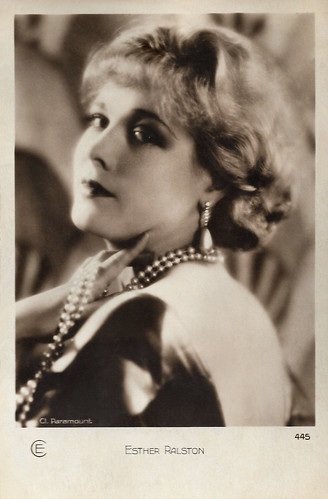
French postcard by Cinémagazine-Edition, Paris, no. 445. Photo: Paramount.
Projected as wholesome but fun-loving, Maine-born leading lady Esther Ralston (1902-1994) enjoyed a prime silent age career. She appeared in close to 100 films over a nearly 30-year period. At her peak, she was packaged and publicised as 'The American Venus' by Florenz Ziegfeld Jr. after appearing as a dazzling beauty queen in the film The American Venus (1926). A decade later, the blonde beauty's career, however, had tapered off.
Image may be NSFW.
Clik here to view.
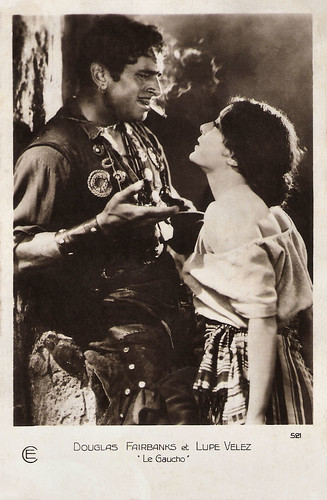
French postcard by Cinémagazine-Edition, Paris, no. 521. Douglas Fairbanks and Lupe Velez in The Gaucho (F. Richard Jones, 1927). Sent by mail in 1930.
American actor Douglas Fairbanks (1883-1939) was best known for his swashbuckling roles in silent films such as The Mark of Zorro (1920), Robin Hood (1922), and The Thief of Bagdad (1924), but spent the early part of his career making comedies. Fairbanks was a founding member of United Artists and of The Motion Picture Academy. Lupe Velez (1908-1944), was one of the first Mexican actresses to succeed in Hollywood. Her nicknames were 'The Mexican Spitfire' and 'Hot Pepper'. She was the leading lady in such silent films as The Gaucho (1927), Lady of the Pavements (1928), and Wolf Song (1929). During the 1930s, her well-known explosive screen persona was exploited in a series of successful films like Hot Pepper (1933), Strictly Dynamite (1934), and Hollywood Party (1934). In the 1940s, Vélez's popularity peaked after appearing in the Mexican Spitfire films.
Image may be NSFW.
Clik here to view.

French postcard by Cinémagazine-Edition, Paris, no. 524.
French actor Jean Murat (1888-1968) became a star as a handsome young soldier in silent films of the 1920s. Later, he appeared in such classic French films as La Kermesse Heroique (1935) and L'Eternal Retour (1943).
Image may be NSFW.
Clik here to view.
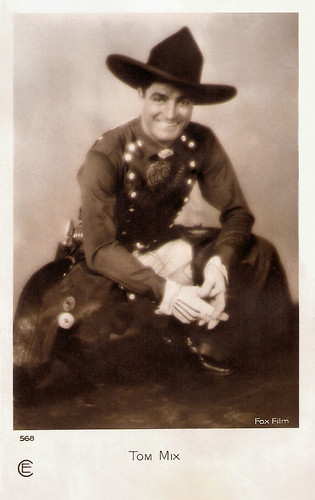
French postcard by Cinémagazine-Edition, no. 568. Photo: Fox Film.
American film actor Tom Mix (1880-1940) was the star of many early Westerns between 1909 and 1935. Mix appeared in 291 films, all but nine of which were silent movies. He was Hollywood's first Western megastar and helped to define the genre for all cowboy actors who followed.
Image may be NSFW.
Clik here to view.
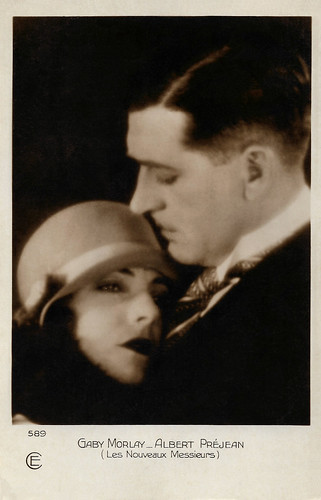
French postcard by Cinémagazine-Edition, Paris, no. 589. Albert Préjean and Gaby Morlay in Les nouveaux messieurs/The New Gentlemen (Jacques Feyder, 1928).
Gaby Morlay (1893-1964) was a French actress with a long-standing career, playing in over 100 films. She compensated for her small size (1.53 m.) with passion and enthusiasm. French actor and singer Albert Préjean (1894-1979) was a former WWI flying ace. He is best known for playing heroes in the silent and early sound films of René Clair, and for playing George Siménon's detective Maigret.
Image may be NSFW.
Clik here to view.

French postcard by Cinémagazine-Edition, Paris, no. 591. Henry Roussel in Les nouveaux messieurs/The New Gentlemen (Jacques Feyder, 1928).
Henry Roussel (1875–1946), also known as Henry Roussell, was a French silent film actor, film director, and screenwriter best known for his silent films of the 1910s and 1920s. He starred in well over 40 films between 1912 and 1939 and directed such films as Visages voilés... âmes closes (1921), Les opprimés (1923), Violettes impériales/Imperial Violets (1924) and Paris' Girls (1929), while in the early 1910s he was a regular actor of the Eclair company, often directed by Maurice Tourneur, and later on had memorable parts in e.g. Les nouveaux messieurs (1929).
Image may be NSFW.
Clik here to view.
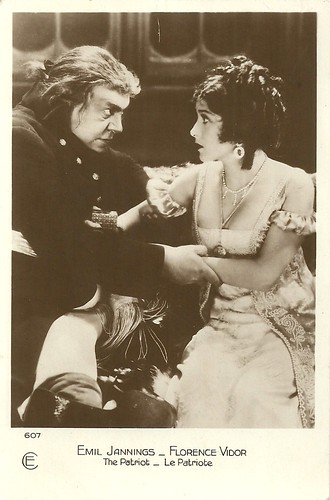
French postcard by Cinémagazine-Edition, no. 607. Emil Janningsand Florence Vidor in The Patriot (Ernst Lubitsch, 1928).
If Weimar cinema had one film star, then it was Emil Jannings (1884-1950) for sure. He was a great actor in the silent era and won the first Oscar for Best Actor. Priceless are his performances as Louis XV in Lubitsch'Madame Dubarry (1919), as the doorman in Murnau's The Last Laugh (1924), the jealous acrobat in Dupont's Variety (1925) and the professor in Von Sternberg's The Blue Angel (1930).
Image may be NSFW.
Clik here to view.

French postcard by Cinémagazine-Edition, no. 608. Emil Jannings again in The Patriot (Ernst Lubitsch, 1928).
Image may be NSFW.
Clik here to view.

French postcard by Cinémagazine-Edition, Paris, no. 613. Dorothy Jordan in Devil-May-Care (Sidney Franklin, 1929). The French title was Bataille de Dames.
Dorothy Jordan (1906-1988) was an American film actress, who emerged at the start of the talkies. She made her film debut in 1929 as Mary Pickford's sister in Sam Taylor's The Taming of the Shrew. Jordan worked for various studios and until 1933 played the female lead in various films. Important parts she had in Min and Bill (1930) with Wallace Beery and Marie Dressler and in The Cabin in the Cotton (1932) with Bette Davis. In 1933 Jordan left the film industry to marry film producer and director Merian C. Cooper.
Image may be NSFW.
Clik here to view.

French postcard by Cinémagazine-Edition, Paris, no. 630. Photo: Paramount.
Burly, beefy and tall George Bancroft (1882-1956) was an American film and stage actor who played many ill-tempered tough guys. He received an Oscar nomination for his part as Thunderbolt Jim Lang in Josef von Sternberg's gangster film Thunderbolt (1929). Bancroft is also well remembered as Marshal Curly Wilcox in John Ford's Western Stagecoach (1939).
Image may be NSFW.
Clik here to view.

French postcard by Cinémagazine-Edition, Paris, no. 660. Photo: Metro-Goldwyn-Mayer. Bessie Love in The Broadway Melody (Harry Beaumont, 1929).
American actress Bessie Love (1898-1986) was introduced to the cinema by D.W. Griffith. He also gave the actress her screen name. She played innocent young girls and wholesome leading ladies in silent films and early talkies. Her acting career spanned eight decades, and her role in The Broadway Melody (1929) earned her a nomination for the Oscar for Best Actress.
Image may be NSFW.
Clik here to view.

French postcard by Cinémagazine-Edition, Paris, no. 707. Photo: Sofar. Anny Ondra in Sündig und süß/Sinful and Sweet (Carl Lamac, 1929), released in France as Anny de Montparnasse.
Anny Ondra (1903-1987) was a Polish-Czech-Austrian-German-French singer, film, and stage actress. During the 1920s and 1930s, she was a popular actress in Czech, Austrian and German comedies, and she was Alfred Hitchcock’s first ‘Blonde’.
Image may be NSFW.
Clik here to view.

French postcard by Cinémagazine-Edition, Paris, no. 738.
Ina Claire (1893-1985) was an American stage and film actress. In the 1910s, 1920s, and 1930s, she was a big Broadway star. She could be seen in several early Pre-Code sound films such as the first version of The Awful Truth (1929), but she is best remembered as Grandduchess Swana in Ninotchka (1939) by Ernst Lubitsch, starring Greta Garbo. Claire was married to actor John Gilbert in 1929-1931.
Image may be NSFW.
Clik here to view.

French postcard by Cinémagazine-Edition, Paris, no. 747. Photo: Alban. Suzanne Bianchetti as Queen Marie-Antoinette of France in the Franco-German coproduction Cagliostro (Richard Oswald, 1929). The year written on the card does not refer to the French release, as that was in 1929 as well.
French film actress Suzanne Bianchetti (1889-1936) was one of France's most loved and respected actresses of her time. She played Marie Antoinette in Abel Gance's epic Napoléon (1927) and worked with many other great names of the silent cinema. After her death the Prix Suzanne Bianchetti was created in her memory, an annual French award to be given to the most promising young actress.
Image may be NSFW.
Clik here to view.

French postcard by Cinémagazine-Edition, Paris, no. 792.
Georges Colin (1880-1945) was a French actor, who appeared in nearly 40 silent and sound films between 1909 and 1945.
Image may be NSFW.
Clik here to view.

French postcard by Cinémagazine-Edition, Paris, no. 928. Photo: Ruben Sobol, Paris.
French film star Annabella (1909-1996) was France's most popular actress during the mid-1930s, but she also achieved some success in Hollywood films of the late 1930s.
Image may be NSFW.
Clik here to view.

French postcard by Cinémagazine-Edition, Paris, no. 929. Photo: Les Films Osso. Albert Préjean and Annabella in Un soir de rafle/Dragnet Night (Carmine Gallone, 1931).
French actor and singer Albert Préjean (1894-1979) was a former WWI flying ace. He is best known for playing heroes in the silent and early sound films of René Clair, and for playing George Siménon's detective Maigret. French film star Annabella (1909-1996) was France's most popular actress during the mid-1930s, but she also achieved some success in Hollywood films of the late 1930s.
Image may be NSFW.
Clik here to view.
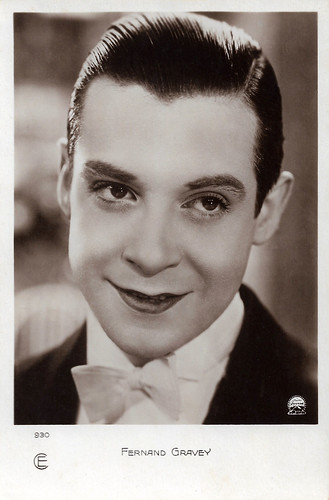
French postcard by Cinémagazine-Édition, Paris, no. 930. Photo: Paramount.
Fernand Gravey (1905-1970) was an elegant Franco-Belgian stage, screen, and television actor, successfully working in Belgium, France, England, and Hollywood. He was also a war hero, who was active as a member of the French Intelligence and in particular for the Foreign Legion during the Second World War.
Image may be NSFW.
Clik here to view.

French postcard by Cinémagazine-Edition, Paris, no. 938. Photo: Paramount.
French actress and singer Meg Lemonnier (1905-1988) was most active in the French cinema of the 1930s.
Image may be NSFW.
Clik here to view.

French postcard by Cinémagazine-Edition, Paris, no. 942. Photo: Metro-Goldwyn-Mayer.
Suave and sophisticated French actor Charles Boyer (1899-1978) began his career in French silent films and in 1936 he became an international star with his role in Mayerling opposite Danielle Darrieux. His long career earned him the title of 'the last of the cinema's great lovers'.
Image may be NSFW.
Clik here to view.

French postcard by Cinémagazine-Edition, Paris, no. 1018. Photo: Studio Rudolph.
French actor Jean Murat (1888-1968) became a star as a handsome young soldier in silent films of the 1920s. Later, he appeared in such classic French films as La Kermesse Heroique (1935) and L'Eternal Retour (1943).
Image may be NSFW.
Clik here to view.

French postcard by Cinémagazine-Edition, Paris, no. 1024. Photo: Studio Intran.
British born, German actress and singer Lilian Harvey (1906-1968) was Ufa's biggest star of the 1930s. With Willy Fritsch, she formed the 'Dream Team of the European Cinema'. Their best film was the immensely popular film operetta Der Kongress tanzt/The Congress Dances (Erik Charell, 1931).
Image may be NSFW.
Clik here to view.

French postcard by Cinémagazine-Édition, Paris, no. 1063. Photo: Paramount. Fernand Gravey in Coiffeur pour dames/Ladies Hairdresser (René Guissart, 1932).
Fernand Gravey (1905-1970) was an elegant Franco-Belgian stage, screen, and television actor, successfully working in Belgium, France, England, and Hollywood. He was also a war hero, who was active as a member of the French Intelligence and in particular for the Foreign Legion during the Second World War.
Image may be NSFW.
Clik here to view.

French postcard by Cinémagazine-Edition, Paris, no. 2007. Photo: Paramount.
French actress and singer Meg Lemonnier (1905-1988) was most active in the French cinema of the 1930s.
Image may be NSFW.
Clik here to view.
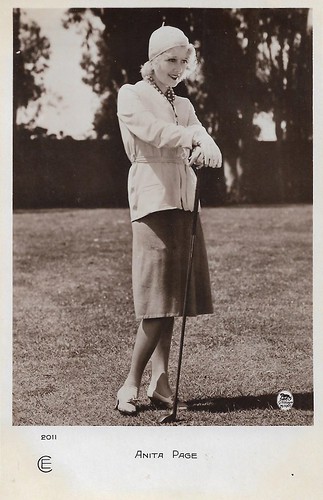
French postcard by Cinémagazine-Edition, Paris, no. 2011. Photo: Metro Goldwyn Mayer.
Beautiful Anita Page (1910–2008) was one of the most popular leading ladies of Hollywood during the last years of the silent screen and the first years of the sound era.
Image may be NSFW.
Clik here to view.
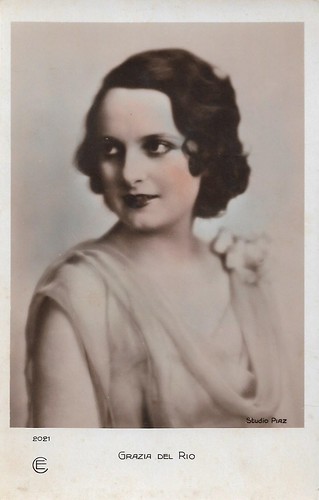
French postcard by Cinémagazine-Editions, no. 2021. Photo: Studio Piaz.
Little is known about the personal life of Italian actress and singer Grazia Del Rio, but probably because of her singing voice and clear vocals she had a prolific career in the earliest years of sound cinema. Between 1930 and 1933 she had a short but intense film career in Italy and France, peaking with La Stella del cinema (Mario Almirante, 1931) in which she starred herself. In the late 1930s, she had a second career in Argentina and Chile.
Image may be NSFW.
Clik here to view.

French postcard by Cinémagazine-Edition, Paris, no. 2067. Photo: Studio Rudolph, Paris.
Christiane Delyne (1902–1966) was an American-born French actress, whose film career peaked in early and mid-1930s French sound cinema.